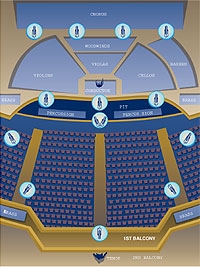Heavenly Surround Page 2
Then what made them worth doing?
"The Berlioz Requiem is one of my favorite pieces in the world," enthused Martone, who is also Telarc's head of production and artist relations. "So when Robert Spano said he was performing it, we said we would like to re-record it because the Atlanta Symphony Chorus is the best in the world."
Yes, re-record: Telarc also did the wildly successful, multi-Grammy-winning 1984 recording of the Requiem in Atlanta with Robert Shaw. "But of course, it wasn't in surround sound," Martone said. "We thought that if any piece would show off the beauty of surround, it would be the Berlioz Requiem." It doesn't hurt that the chorus, now under the direction of Norman Mac-kenzie, sounds nothing short of spectacular.
Much of the credit for the excellent SACD must go to Spano. When I met him in New York , he was in town to conduct an entirely different sort of requiem - the John Adams opera The Death of Klinghoffer - at the Brooklyn Academy of Music. He seemed comfortable at the Chelsea Hotel, whose residents have ranged from Dylan Thomas to Bob Dylan, from Vir-gil Thomson to Sid Vicious. And Spano was certainly comfortable talking about multichannel music.
"The Berlioz Requiem is essentially 19th-century surround sound," he said. "The acoustic phenomena - the number of timpani, the four brass choirs, the chorus itself, and the tenor up in the balcony - those features are the salient reasons why this piece is great for multichannel. But it also has these very quiet and very intimate things. And everything in between. It's not just the extremes, it's the whole range in the density of activity and the multiplicity of sound sources that make the Requiem ideal for surround." Spano and the orchestra handle it all brilliantly, from the explosive outbursts of the Dies Irae and "Rex tremendae" to the austerely devotional "Quaerens me."
Beyond that, because he didn't record the work live in Symphony Hall, the challenge for Spano was "to get a performance sensibility to come across without the audience. There's something that occurs in live performance that is spontaneous, brash, and vital. When we record, we have the memory of what we did in performance, and we aspire to deliver that kind of energy and intensity. And Telarc is very conscious of capturing the sound that we ideally want to hear."
|
Spano didn't do a live recording because the acoustics of the cast-concrete Symphony Hall are problematic. But with the three concerts done and the audiences gone, Tel-arc's engineering team was able to convert the hall into a more recording-friendly environment. This involved covering the auditorium seats as well as the side and back walls with 220 sheets of plywood to make the sound warmer.
Spano said he listened to playbacks frequently during the recording sessions. "My attitude is to play for what we're delivering to the microphones - which is different from what's happening in the room, of course. On the podium, my subjective perception of the way the sound is unfolding is completely different from what I hear when I get the headphones on. So when I'm standing there and we're recording, I'm trying to listen with my headphone ears, because that's what we're going to end up with."
- Log in or register to post comments





















































